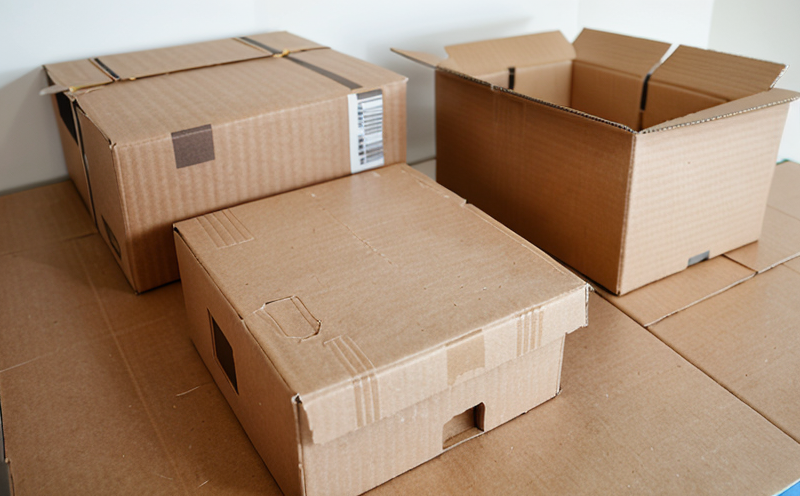ISO 5636-4 Smoothness Testing
The ISO 5636 series of standards provides a comprehensive framework for the testing and evaluation of paper, board, and related materials. Specifically, ISO 5636-4 focuses on smoothness measurements using the Schopper method. This test is particularly relevant in sectors such as packaging where the quality of the material can significantly influence the performance and aesthetics of the final product.
The smoothness of paper and cardboard is a critical parameter that affects various aspects of its use, including printability, folding strength, and overall appearance. In packaging applications, it ensures that the printed graphics are clear and consistent across different products. The test helps manufacturers ensure that their materials meet industry standards and customer expectations.
The Schopper method is based on measuring the resistance to flow of ink or other liquids over the surface of the material when they form a meniscus. This provides an indirect measure of the surface texture, which is closely related to smoothness. The test apparatus typically consists of a specially designed ink reservoir and a flexible blade that is brought into contact with the specimen.
The process involves placing the sample on the testing device and allowing it to come to equilibrium under controlled conditions. Once stable, the blade is drawn across the surface at a constant speed. The resistance encountered by the blade provides data from which smoothness values can be calculated.
For accurate results, specimens must be prepared according to ISO guidelines. This includes ensuring that samples are cut to standard dimensions and conditioned in a controlled environment before testing. Proper conditioning ensures that the moisture content of the sample is consistent with real-world conditions, leading to more reliable test results.
The Schopper method has been widely adopted due to its simplicity and repeatability. It allows for quick assessment of smoothness properties which are essential in industries where time-to-market is crucial. However, it's important to note that while this method provides useful insights into the surface characteristics of paper and cardboard, it does not capture all aspects of texture.
For those looking to deepen their understanding or compare results with other methods like the Marsh Method (ISO 5636-1) for measuring stiffness, further reading on these topics can provide additional context. The choice between different testing protocols often depends on specific application requirements and industry best practices.
In summary, ISO 5636-4 smoothness testing is a fundamental tool in ensuring that paper and cardboard used in packaging meet the necessary quality standards. By providing precise measurements of surface texture, it supports critical decisions throughout the product lifecycle—from R&D to manufacturing and beyond.
Why It Matters
The importance of ISO 5636-4 smoothness testing cannot be overstated, especially in industries where the quality of materials directly impacts customer satisfaction. Smooth paper and cardboard contribute significantly to product performance by enabling better printing results and enhancing overall aesthetics.
- Enhanced printability: A smoother surface allows for clearer and more vibrant prints without noticeable artifacts or distortions.
- Better folding strength: Smoother materials tend to fold more easily, reducing the risk of tears or damage during handling and use.
- Aesthetics: Consistent smoothness across a batch ensures uniform appearance in packaging design, which is crucial for brand identity.
- Process efficiency: Ensuring consistent quality through testing helps streamline production processes by minimizing rework and scrap rates.
In today’s competitive market, maintaining high-quality standards is paramount. Companies that adhere to these tests can gain a strategic advantage by delivering superior products that meet or exceed customer expectations.
Scope and Methodology
The ISO 5636-4 standard specifies the procedure for determining smoothness using the Schopper method. This involves measuring the resistance to flow of ink or other liquids over the surface of paper, board, and similar materials. The test setup includes a specially designed ink reservoir connected to a flexible blade which is drawn across the sample at a specified speed.
The specimen must be prepared according to ISO specifications, ensuring it represents actual manufacturing conditions as closely as possible. After conditioning in a controlled environment, the sample is placed on the testing device and allowed to reach equilibrium. Once stable, the blade is brought into contact with the surface and moved at a constant speed.
The resistance encountered by the blade during this process provides data from which smoothness values can be calculated. These values are then reported according to ISO conventions. For accurate results, it's crucial that all steps in the procedure are followed rigorously.
It’s worth noting that while this method offers valuable insights into surface texture, it has limitations. It does not fully capture variations in roughness or other micro-structural features that might affect certain properties like adhesion or absorption rates. Therefore, for comprehensive evaluation, multiple testing methods may be employed depending on the specific requirements of the application.
The Schopper method is widely recognized and used across various sectors including printing, packaging, and publishing. Its simplicity and reliability make it an ideal choice when quick assessments are needed without extensive laboratory facilities.





